|
83. Erebia medusa (Denis & Schiffermüller, 1775) / Woodland ringlet / Nymphalidae – Satyrinae
NL: voorjaarserebia / D: Mohrenfalter, Rundaugen-Mohrenfalter, Früher Mohrenfalter / F: moiré franconien, le franconien
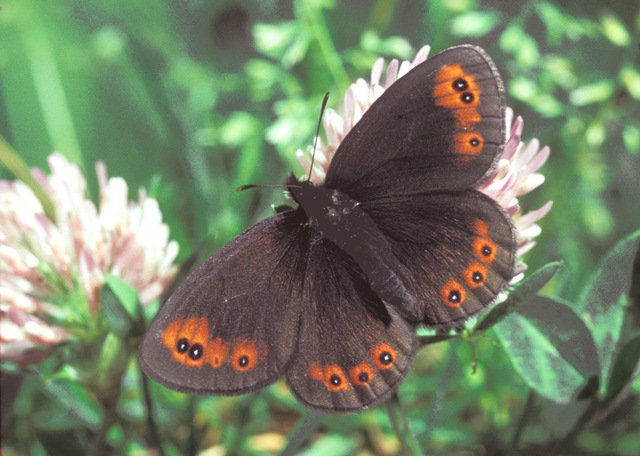 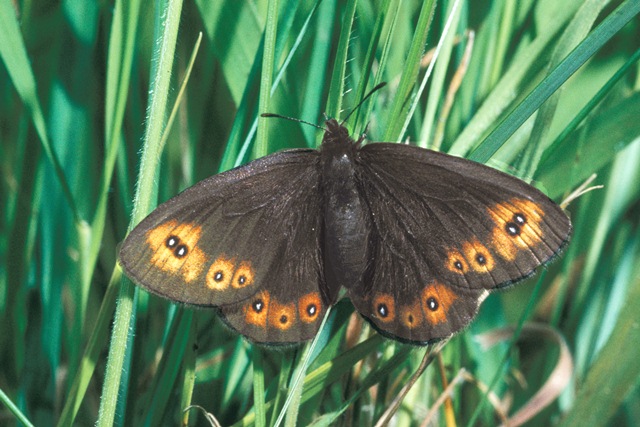 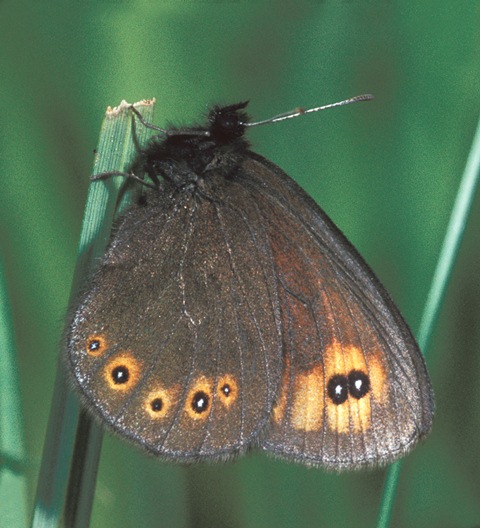
Photographs: Frits Bink ©.
Medium-sized, wing length 21 (19-23) mm. In the Benelux the species occurs in the Ardennes of Luxemburg and Wallonia where it inhabits marshy sites with a vegetation of sedges and also dry and warm chalk grassland with tall grass.
Butterfly is on the wing from early-May until early-July and peaks end-May and early-June.
The species is known from sub-continental to severe continental climates, amplitude 8 to 20. Required heat sum 400°d and maximum tolerated 1500°d, corresponding climate windows 19 to 33 weeks.
The species occurs on most sites in one generation per year. In north Finland Erebia polaris (Staudinger 1861), a very closely related species, occurs in a climate where the growing season is much too short for larval development within one year and thus has a two year life cycle with two overwintering stages, as small larva and a second one as a big larva (Henriksen & Kreutzer 1982: 116).
Ecological characteristics
Behaviour over time
Overwintering: half grown larva, fourth instar, 10 mm in length, hidden in a tussock of its host-plant.
Reproduction: oviposition starts after 3-5 days when the body contains 42 (34-49) eggs, estimated potential 2.4 times as much.
Larval feeding periods: summer 70 (53-86) days from end-June until early-September, in next spring 53 (34-71) days from end-March until end-May.
Generations: one.
Spreading of risk: not observed.
Life cycle: egg (14 (10-16) days; larva 43-47 weeks; pupa 17 (17-23) days.
Life span of adult: short, 2 weeks.
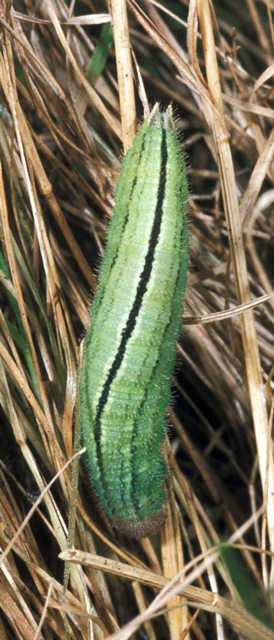 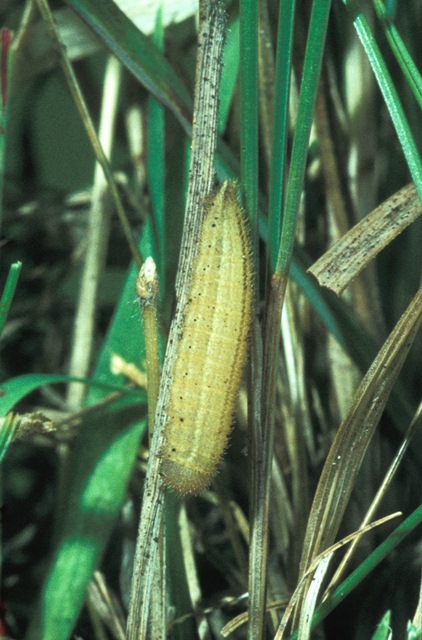
Photographs: Frits Bink ©.
Behaviour in space
From stay-at-home to migrant: stay-at-home, spatial requirement modest.
Finding a mate: male patrols.
Orientation in the landscape: edges of woodland, tall grassland.
Oviposition: randomly on stem of the host on a selected site.
Defence
Threats from other organisms: avoidance by hiding in the larval stage.
Threats from the environment: little, species occurs as well in marshes as in dry and warm chalk grassland.
Feeding habits
Adult: nectar of all kinds of flowers.
Larva: nocturnal in summer.
Larval foodplants
Plant species: Cyperaceae, Carex nigra, C. pilulifera, Poaceae, e.g. Brachypodium pinnatum, Festuca rubra, Phleum pratense, Molinia caerulea.
Journal
Rearing experiment based on specimen from Baraque de Fraiture, Belgium:
15 June 1980: one female captured.
27 July: larvae 5 mm in length.
17 August: larvae 12 mm in length.
Overwintered outdoors.
24 January 1981: pot with tussock taken indoors, one larva 16 mm, basking, yellowish coloured.
18 February: two larvae dead, swollen up, others had shrunk to 10 mm.
6 March: biggest larva moulted, now fifth instar.
24 March: largest larva had pupated.
16 April: first adult appeared.
22 April: second one hatched.
Table 83-1. Results of dissections

Table 83-2. Collection and observation localities
B, Baraque de Fraiture, 550 m, 50° 14’ 32”N – 5° 46’ 58”E; 15 June 1980.
B, Ethe, 240 m, 49° 36’ 25”N – 5° 35’ 50”E; 19 June 1983.
D, Blankenheim 50° 22’ 40”N – 6° 41’ 05”E; 20 June 1983.
D, Kaub 50° 05’ 36”N – 7° 45’ 43”E; 26 May 1986.
F, Lorraine, Lion-devant-Dun, 300 m, 49° 23’ 40”N – 5° 14’ 03”E; 12 June 1984.
F, Montmédy, 217 m, 49° 31’ 07”N – 5° 21’ 33” E; 12 June 1984.
Fig. 83-1. Erebia medusa, phenogram adapted from Fichefet et al. 2008: 209.
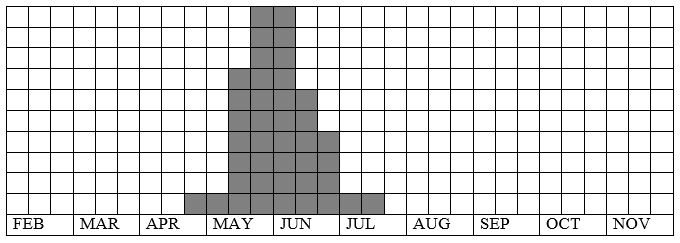
Fig. 83-2. Erebia medusa, habitat characteristics.
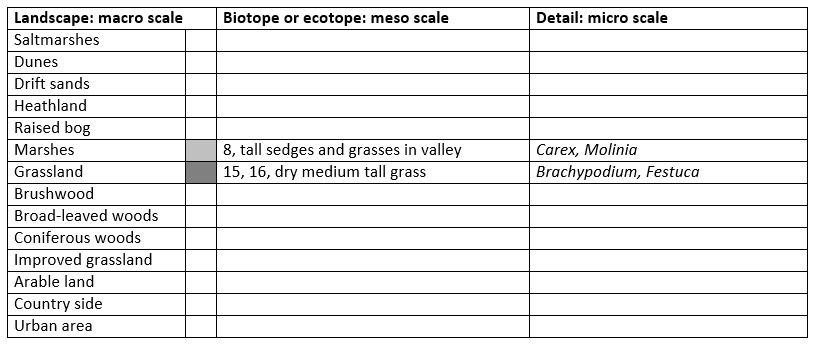
Fig. 83-3. Erebia medusa, climate matrix, heat-sums 400 - 1500°d. Darker part: Erebia medusa polaris , heat-sums 80-160°d (2 years cycle).
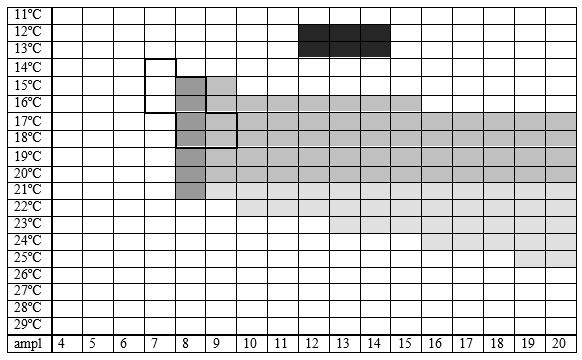
|










